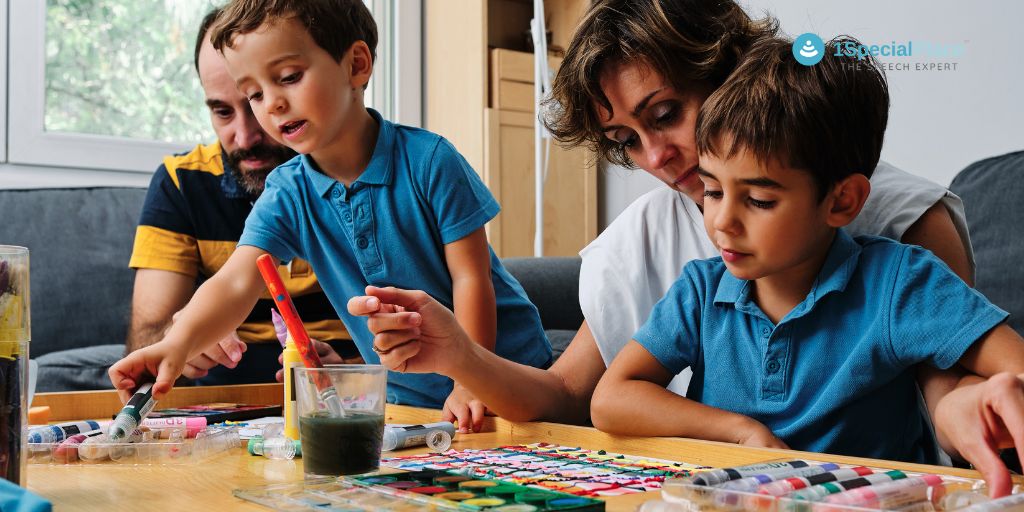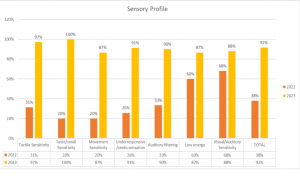
Case Study: Improvements in Sensory Profile & Motor Skills of a Child with ASD and Seizure Disorder (2022-2023)
Case Study: Improvements in Sensory Profile & Motor Skills of a Child with ASD and Seizure Disorder (2022-2023)
This is a Case Study- showing Improvements in Sensory Profile & Motor Skills. This is a Child with ASD and Seizure Disorder. This improvements were seen in an year through Online Occupational Therapy sessions.
Patient Background: The subject of this case study is an 8-year-old child diagnosed with Autism Spectrum Disorder (ASD) and a concurrent seizure disorder. The child’s sensory profile and motor skills were assessed over a one-year period, from 2022 to 2023, to track their progress in managing sensory sensitivities and challenges and improving their motor skills.
Assessment and Intervention: Comprehensive set of assessments were done for child’s sensory profile evaluation. It included questionnaires, caregiver reports, direct observations, and professional evaluations. The primary focus was on assessing various sensory domains. It included tactile sensitivity, taste/smell sensitivity, movement sensitivity, underresponsiveness/seeks sensation, and visual/auditory sensitivity. The child’s sensory challenges were addressed through a combination of therapy and support.
Graph of Sensory Profile Improvements:
Improvements in Sensory Profile of a Child with ASD and Seizure Disorder
Key Observations:
Tactile Sensitivity: The child demonstrated a remarkable 97% improvement in tactile sensitivity, with a substantial increase from 11 in 2022 to 34 in 2023. This reflects significant progress in how the child responds to tactile stimuli.
Taste/Smell Sensitivity: Taste and smell sensitivity showed an impressive 100% improvement, with values increasing from 4 in 2022 to 20 in 2023. The child’s sensory experiences in this area have seen a remarkable transformation.
Movement Sensitivity: The child exhibited an 87% improvement in movement sensitivity, with values rising from 3 in 2022 to 13 in 2023. This indicates a substantial positive change in how the child perceives and processes movement-related stimuli.
Underresponsive/Seeks Sensation: Responsiveness and sensation-seeking behavior significantly improved, with values increasing from 9 in 2022 to 32 in 2023, representing a 91% enhancement.
Auditory Filtering: The child’s ability to filter auditory stimuli notably improved, with values increasing from 10 in 2022 to 27 in 2023, demonstrating a 90% positive change.
Low Energy: Energy levels increased from 18 in 2022 to 26 in 2023, showcasing an 87% improvement in the child’s overall activity and engagement.
Visual/Auditory Sensitivity: Sensitivity to visual and auditory stimuli improved, with values rising from 17 in 2022 to 22 in 2023, marking an 88% enhancement.
The overall sensory profile of the child has undergone significant positive changes, with the total score increasing from 72 in 2022 to 174 in 2023, representing a substantial 92% improvement.
Improvements in Motor Skills of a Child with ASD and Seizure Disorder –
Improvement in Motor Skills: Besides sensory challenges, the child struggled with fine motor skills, received tailored intervention and support.
Initial Assessment (Fine Motor Skills): In 2022, the child had significant deficits in fine motor skills. It was hindering their drawing and writing abilities.
Intervention Strategies for Fine Motor Skills: A multidisciplinary team designed an intervention plan. Employ Occupational therapy and adaptive tools to enhance the child’s fine motor skills.
Occupational Therapy: The child received regular occupational therapy sessions that focused on improving hand strength, fine motor coordination, and grip. Activities included exercises to strengthen the hand and finger muscles. Activities like squeezing theraputty, manipulating small objects, and using specialized hand-strengthening activities.
Adaptive Tools: The child was provided with adaptive tools to facilitate a better pencil grip. Adaptive tools such as pencil grips, jumbo pencils, weighted cuffs, and textured writing surfaces. These tools aided in stabilizing the hand and promoting a functional pencil grasp.
Sensory Integration: Therapy sessions incorporated sensory integration techniques to address sensory sensitivities and improve fine motor skills.
Individualized Education Plan (IEP): Adjusted the child’s education plan to include one-on-one support and provided personalized guidance. Also provided assistance during writing and fine motor activities as part of the Individualized Education Plan (IEP).
Progress and Outcomes (Fine Motor Skills):
Over the intervention period, the child significantly improved their pencil grip. He also achieved independent writing, and displayed reduced frustration.
Improved Pencil Grip: The child transitioned from an unstable and weak pencil grip to holding the pencil with a firm and functional grip. This improvement enabled the child to control the writing instrument effectively.
Independent Writing: With minimal assistance, the child gained the ability to write letters, shapes, and simple words. The child’s fine motor progress reflects in their increased independence and confidence during writing tasks.
Decreased Frustration: The child’s decreased frustration with fine motor activities was evident. Additionally, it showed a more positive attitude toward writing and drawing tasks.
Conclusion:
This case study highlights the improvements in Sensory Profile & Motor Skills, made by a child with ASD and a seizure disorder. In terms of sensory processing and fine motor skills, through comprehensive and individualized intervention. Multidisciplinary collaboration and tailored interventions can positively impact the functioning and quality of life for such children.
Click here to read more case studies


Leave a Comment
(0 Comments)